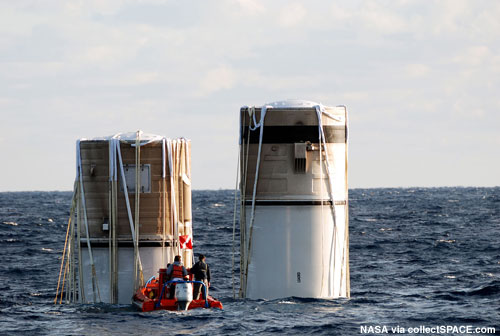|
Author
|
Topic: STS-116 SRBs tangled together
|
Robert Pearlman
Editor Posts: 42988
From: Houston, TX
Registered: Nov 1999
|
 posted 12-11-2006 02:18 PM
posted 12-11-2006 02:18 PM
   
From [email protected]: quote:
The picture below shows how mother nature and booster dynamics in the marine environment can team up to make things interesting.Before you ask - no there was no contact made. Liberty had watched the LH progressing toward the RH during the night and prior to this shot had taken the risers from the LH (higher in the water with more sail area) and applied what force it could to alter the path sufficiently to avoid contact. During the passing, the divers were in the water performing their assessment of the RH and have this downwind race on video.
 From a [email protected]: quote:
The STS-116 SRB's landed about a 1/2 mile away from each other...look at them now. Retrieving these boosters will NOT be easy. All six parachutes (each half the size of a football field) are all tangled up 150 ft below the surface.
|
Robert Pearlman
Editor Posts: 42988
From: Houston, TX
Registered: Nov 1999
|
 posted 12-11-2006 05:19 PM
posted 12-11-2006 05:19 PM
   
For those unfamiliar:"Liberty" in the first note refers to the Liberty Star, one of two solid rocket booster recovery ships used by NASA. "LH" and "RH" refer to left- and right-hand boosters, as oriented when they are attached to the external tank for launch. |
mjanovec
Member Posts: 3811
From: Midwest, USA
Registered: Jul 2005
|
 posted 12-11-2006 06:37 PM
posted 12-11-2006 06:37 PM
   
I wonder if they could just cut the chute lines off of the boosters in order to recover the boosters. Granted, that might mean sacrificing the chutes (or at least the lines that attached to the chutes). But it might be safer and faster (and perhaps cheaper) than trying to untangle the chutes underwater...presumably using divers to do the job.Have any boosters ever not been fully recovered (other than from 51-L)? [Edited by mjanovec (December 11, 2006).] |
Apollo-Soyuz
Member Posts: 1205
From: Shady Side, Md
Registered: Sep 2004
|
 posted 12-11-2006 07:04 PM
posted 12-11-2006 07:04 PM
   
I believe the boosters from STS-4 sank after a parachute malfunction and were photgraphed underwater. They were not recovered.        ------------------
John Macco
Vice President
Space Unit
Shady Side, Md. |
Robert Pearlman
Editor Posts: 42988
From: Houston, TX
Registered: Nov 1999
|
 posted 12-11-2006 08:55 PM
posted 12-11-2006 08:55 PM
   
According to John Shannon, Mission Management Team Chair, during tonight's MMT briefing: quote:
"They do have the solid rocket boosters attached to the ships. We expect those to be back in the port late tomorrow night, and we will do the the open assessment on Wednesday."
Shannon didn't know how they freed the boosters from each other, but was waiting for an explanation from Robert Lightfoot, the Shuttle Propulsion Manager at MSFC.[Edited by Robert Pearlman (December 11, 2006).] |
Rob Joyner
Member Posts: 1308
From: GA, USA
Registered: Jan 2004
|
 posted 12-11-2006 11:23 PM
posted 12-11-2006 11:23 PM
   
Anyone know at what latitude the STS-116 SRB's landed or approx. off-shore vicinity, (Daytona, St. Augustine, Jax, etc.)?
|
Robert Pearlman
Editor Posts: 42988
From: Houston, TX
Registered: Nov 1999
|
 posted 12-12-2006 12:56 AM
posted 12-12-2006 12:56 AM
   
Additional information via John Shannon: quote:
FOULED CHUTES
It is common to have tangled (fouled) parachutes. Our Marine Ops Group encounters this regularly. They do not untangle (de-foul) the chutes prior to reeling them up. At the Parachute Refurbishment Facility we have a de-foul deck where we unspool and untangle the parachutes prior to washing them. Since this is a common scenario and a routine operation we do not consider it to be an item that requires a special report. It take slightly longer to reel in the parachutes if a significant amount of fouling occurs.SRB's PASSING BY EACH OTHER
As you can see in the picture, one SRB is sitting higher in the sea than the other SRB. This has to do with the amount of air that is trapped in the SRB and is highly variable. When one SRB is sitting higher in the water and the wind is blowing it moves faster than the other SRB. In this case the lower SRB was upwind and the higher SRB came passing by. Our Marine Ops group monitors this movement and if the SRBs get close to each other they will attach one of the SRB riser lines to the AMBAR Motor Boat and gently float it away from the path until the other SRB passes by.
|













